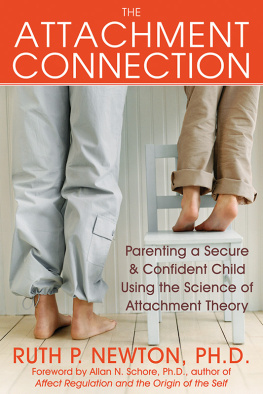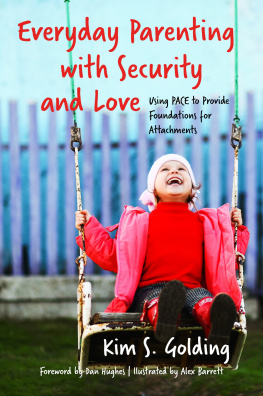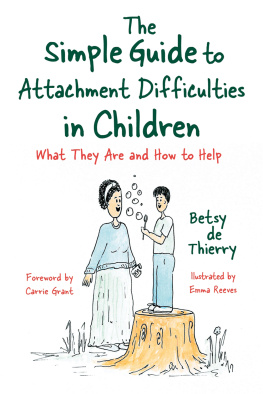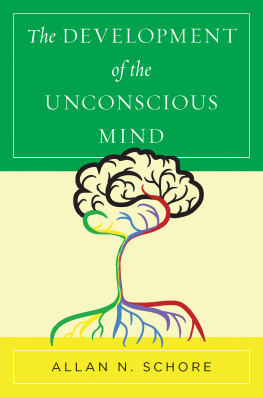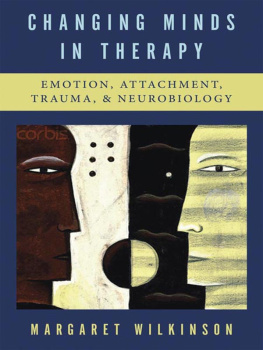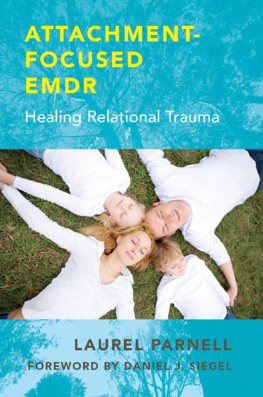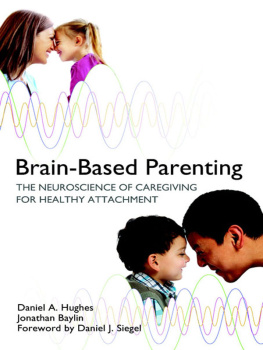
The Norton Series on Interpersonal Neurobiology
Louis Cozolino, PhD, Series Editor
Allan N. Schore, PhD, Series Editor, 20072014
Daniel J. Siegel, MD, Founding Editor
The field of mental health is in a tremendously exciting period of growth and conceptual reorganization. Independent findings from a variety of scientific endeavors are converging in an interdisciplinary view of the mind and mental well-being. An interpersonal neurobiology of human development enables us to understand that the structure and function of the mind and brain are shaped by experiences, especially those involving emotional relationships.
The Norton Series on Interpersonal Neurobiology provides cutting-edge, multidisciplinary views that further our understanding of the complex neurobiology of the human mind. By drawing on a wide range of traditionally independent fields of researchsuch as neurobiology, genetics, memory, attachment, complex systems, anthropology, and evolutionary psychologythese texts offer mental health professionals a review and synthesis of scientific findings often inaccessible to clinicians. The books advance our understanding of human experience by finding the unity of knowledge, or consilience, that emerges with the translation of findings from numerous domains of study into a common language and conceptual framework. The series integrates the best of modern science with the healing art of psychotherapy.
The Neurobiology of Attachment-Focused Therapy

Enhancing Connection and Trust in the Treatment of Children and Adolescents
Jonathan Baylin and Daniel Hughes

W. W. Norton & Company
Independent Publishers Since 1923
New York London
A Norton Professional Book
For Youngblood and Tyree and the yet unborn to B. and A., the future Jonathan Baylin
For the Members of the DDPI Community Daniel Hughes

Contents

Three Layers of Transparency
The screen door is partially open
to allow for the cat to come in
and go out at his leisure
This space opens to the outside air
and my arm could easily reach through
to that freshness
The screen door, in a more reserved and veiled way,
also allows the cool morning air
to pass through to the inside
Further to the left of the screen is the glass sliding door
a hard clear shell that, too, allows light to pass through
but clearly defines inside and outside,
Three layers of transparency,
three ways of being
There are times I am glass
when I allow things in and peer out at the world
but remain separate and distinctly myself
At times I am the screen
permeable, allowing light and air to pass through from
either side
with only a skin of protection
when trust has begun to deepen with ones I love
And the open space, thats what I long to be
when all barriers have dissolved
when the air inside is no different than the air outside
and I am free to roam fearlessly in all the spaces
When compassion for myself floods into the open space of
compassion for all
Eric Baylin, August 2015
Stephanie and Chad were quite happy with their life together in a peaceful suburb on the outskirts of St. Louis. They had two remarkable teen girls who seemed to defy the rumors that the teen years would be rocky, good careers that were satisfying and provided for their needs and more, and strong extended familieswhat more could they ask for? They felt they had more to give and more room in their family for a child who needed a home. After many discussions with their daughters, friends, and a social worker, they chose to adopt, and within a year welcomed nine-year old Mark into their home. He had a very difficult history but seemed to be doing well in his latest foster home and they had confidencesupported by their social workerthat they could provide Mark with the home he needed.
Within four or five months, they began to have doubts. They had been patient with Marks forgetfulness about the rules and few chores he was assigned. They knew he needed time to adjust, but after the first few weeks when he seemed to show a forced cheerfulness, he seemed chronically unhappy. He did not seem to enjoy things they did for him or with him. Nor did he ask for their help when he couldnt do something or when he made a mistake. Instead, he would lie about his mistakes and become irritated when they doubted him. Gradually his irritation became anger and his anger became severe, marked with threats and running to his room and refusing to talk.
Stephanie and Chad sought psychological treatment and spoke with a counselor while Mark saw his own therapist. After another four or five months, their doubts increased. The therapist said that Mark needed time, but his behavior was only getting worse at home and at school. What bothered them the most was what Mark said to them. Often he said that he hated them, he didnt want to live with them, they werent his parents and never would be. When they gave him consequences for his behavior, he would threaten to pay them back and then he did. Things in their home disappeared or were broken. The hardest was when Mark started to treat their daughters as badly as he treated them.
A year after Mark entered their home, they barely remembered the family they used to have, the family they wanted to share with him. They bickered with each other and spent more time away from home. They now experienced little laughter or joy. Stephanie and Chad were convinced that they had made a horrible mistake in adopting Mark. They felt trapped. They had long since stopped feeling love for him. He was a duty, a job. What had happened?
After receiving good care from Stephanie and Chad for a year, Mark still did not trust them. If anything, he trusted them less, finding more reasons each day to justify never trusting them. As the weeks and months passed and their irritation increased, he became more convinced that they were not trustworthy. What would it take for Mark to move from mistrust to trust? Whatever it was, it was now less likely to happen because Stephanie and Chad began to stop caring. If good care was not helping, poor care was not likely to do so. It was now a perfect storm. Mark came to his adoptive family with blocked trust, and nothing that his adoptive parents, social worker, or therapist could do enabled him to begin to trust. Stephanie and Chad were now in blocked care. Even if Mark were somehow able to take a tentative step toward beginning to trust, they were not likely to see it or respond to it. Their primary response was defensiveness. They were protecting their hearts from the pain of enduring his anger and rejection for months and months.
This book is written for people like Mark, Stephanie, and Chad. If trust is to develop and care is to be restored, we have to know what is preventing the development of trust in the first place when a child is living in an environment of good care for a long period of time. What do abuse and neglect do to the development of childrens brains that makes it so difficult for them to trust adults who are so different from those who hurt them? We have to know what weboth parents and professionalsmight do to encourage the development of such trust.
Next page



